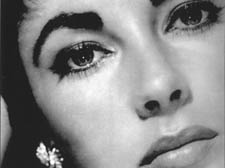|
|
 |
| |

Elizabeth Taylor |
The eyes always had it for ‘living work of art’
Elizabeth Taylor was considered the most beautiful woman in the world. Her secret was simple, explains William Hall
ELIZABETH
by J Randy Taraborrelli,
Sidgwick and Jackson, £18.99.
THE eyes have it. But then, with Elizabeth Taylor they always did, ever since she was born with double eye lashes around those lustrous, amazingly violet orbs which would transfix us the way a candle transfixes a moth. I know, because I felt their impact on several occasions – on film sets in the UK and Hollywood, and at various London watering holes.
Small wonder a host of swains queued at the feet of the star once hailed as “the most beautiful woman in the world”.
Photographer Tom Gates would describe her face as “a perfect sculpture, a living work of art”. This was one ravishing beauty whose appeal surely matched that of her most famous character. Cleopatra, who else?
In his biography Elizabeth, author J Randy Taraborrelli takes 60 – repeat, 60 – pages to acknowledge everyone who helped him in his massive research, even though he appears not to have actually met his star.
No matter. He harvests a vast field of information and no stone remains unturned.
Elizabeth was born on February 27, 1932, and grew up in No 8, Wildwood Road, Hampstead, a red-brick mansion looking out on to the Heath extension, complete with swimming pool and tennis court.
It would set the tone for the rest of her life. Poverty was not a word Elizabeth Taylor ever needed in her vocabulary.
Her father Francis owned an art gallery, while her actress mother Sara gave up the stage to be with their two children, Howard and Elizabeth.
She went to Byron House School in Highgate for a few terms before her parents whisked her back to America in 1939 as the war clouds gathered. They settled in California, where her ambitious mother began a determined onslaught on the studios.
MGM mogul Louis B Mayer was the first to spot a potential asset.
“Sign her up!” he ordered after a chance meeting on one of the sets. These were the days when the studios groomed their child stars for future investment, among them Shirley Temple, Mickey Rooney and Roddy McDowall, loaning them out to other studios as well.
Indeed, 20th Century Fox used Elizabeth just once in Jane Eyre (1944), with only three minutes (but including a useful death scene) on screen.
It was enough. “A staggering amount of wisdom was apparent in her acting, far exceeding her years,” writes Taraborrelli.
Roddy McDowall, then 13, starred with her in the enduring Lassie Come Home, and recalled: “They said: ‘Get that girl off the set! She has too much eye-make up.’ They started rubbing at her eyes with a moist cloth – then found she had no mascara on! She had a double set of eye-lashes! That girl was born to be on the big screen.”
Others agreed. MGM gave her the lead in National Velvet, and such was its success that they signed her to a long-term contract.
They also gave her the horse she rode in the film as a 13th birthday present, an ironic twist given that Elizabeth suffered a fall during filming that plagues her with excruciating back pain to this day.
“It was actually a scripted fall,” reveals the author. “Most people assume it was a stunt double who took that spill. But it truly was Elizabeth. She hit the turf on her back and bounced off.”
Much later, with frequent spells in a wheelchair, she would say: “Sometimes I get so angry at my body. Not many people have a medical history like mine!”
But she came through it all, her sense of humour somehow intact.
Her stunning performance in Who’s Afraid of Virginia Woolf? deservedly won her a best actress Oscar in 1966 – she already had one for Butterfield 8.
Now she was one of the world’s highest-paid stars, on a roll with a string of memorable movies: Giant, Raintree County, Cat on a Hot Tin Roof, Suddenly Last Summer, X, Y and Zee (filmed in Highgate) and The Comedians are just a few that demonstrated her range.
In her later years she fought alcoholism and health problems – she came through a brain tumour in 1997 – but still appeared in several TV mini-series while becoming active in charities and raising millions for Aids research.
Elizabeth Taylor’s private life was as volatile as her screen roles. She had “ripened early”, dating Howard Hughes and taking her first marriage vows (to hotelier Nicky Hilton) before she was 18. After that the list of husbands reads like a roll call for celebrity weddings. Actor Michael Wilding, producer Mike Todd, singer Eddie Fisher, Richard Burton (two marriages, two divorces) and on to US senator John Warner before a damp-squib finale to construction worker Larry Fortensky (20 years her junior) in 1991, ending in another divorce.
As one wag quipped: “Always a bride, never a bridesmaid.” How cruel. But how true.
|
 |
 |
|
 |
|


